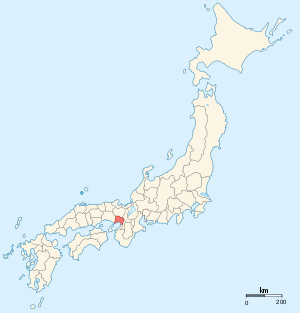
Settsu Province
Encyclopedia

Provinces of Japan
Before the modern prefecture system was established, the land of Japan was divided into tens of kuni , usually known in English as provinces. Each province was divided into gun ....
of Japan
Japan
Japan is an island nation in East Asia. Located in the Pacific Ocean, it lies to the east of the Sea of Japan, China, North Korea, South Korea and Russia, stretching from the Sea of Okhotsk in the north to the East China Sea and Taiwan in the south...
, which today comprises the eastern part of Hyōgo Prefecture
Hyogo Prefecture
is a prefecture of Japan located in the Kansai region on Honshū island. The capital is Kobe.The prefecture's name was previously alternately spelled as Hiogo.- History :...
and the northern part of Osaka Prefecture
Osaka Prefecture
is a prefecture located in the Kansai region on Honshū, the main island of Japan. The capital is the city of Osaka. It is the center of Osaka-Kobe-Kyoto area.- History :...
. It was also referred to as or .
Osaka and Osaka Castle
Osaka Castle
is a Japanese castle in Chūō-ku, Osaka, Japan.Originally called Ozakajō, it is one of Japan's most famous castles, and played a major role in the unification of Japan during the sixteenth century of the Azuchi-Momoyama period.-Description:...
were the main center of the province.
History
During the Sengoku periodSengoku period
The or Warring States period in Japanese history was a time of social upheaval, political intrigue, and nearly constant military conflict that lasted roughly from the middle of the 15th century to the beginning of the 17th century. The name "Sengoku" was adopted by Japanese historians in reference...
, the Miyoshi clan
Miyoshi clan
The Miyoshi clan is a Japanese family descended from Emperor Seiwa and the Minamoto clan . They were a cadet branch of the Ogasawara clan and the Takeda clan....
ruled Settsu and its neighbors, Izumi
Izumi Province
was a province of Japan. It is also referred to as . It lay in Kinai, and its area today composes the south-western part of Osaka Prefecture . The Ōshōji in Sakai was the border with Settsu Province, until the beginning of the Meiji period, when the boundary was changed to be at the Yamato River...
and Kawachi
Kawachi Province
was a province of Japan in the eastern part of modern Osaka Prefecture. It originally held the southwestern area that was split off into Izumi Province...
, until they were conquered by Oda Nobunaga
Oda Nobunaga
was the initiator of the unification of Japan under the shogunate in the late 16th century, which ruled Japan until the Meiji Restoration in 1868. He was also a major daimyo during the Sengoku period of Japanese history. His opus was continued, completed and finalized by his successors Toyotomi...
. The provinces were ruled subsequently by Toyotomi Hideyoshi
Toyotomi Hideyoshi
was a daimyo warrior, general and politician of the Sengoku period. He unified the political factions of Japan. He succeeded his former liege lord, Oda Nobunaga, and brought an end to the Sengoku period. The period of his rule is often called the Momoyama period, named after Hideyoshi's castle...
. The regents
Council of Five Elders
The council of five elders, also known as the five Tairō , was formed by Toyotomi Hideyoshi to rule Japan in the place of his son, Hideyori, until such time as he came of age. Hideyoshi chose his five most powerful daimyo: Ukita Hideie, Maeda Toshiie, Uesugi Kagekatsu, Mōri Terumoto, and the...
of Hideyoshi's son soon quarreled, and when Ishida Mitsunari
Ishida Mitsunari
Ishida Mitsunari was a samurai who led the Western army in the Battle of Sekigahara following the Azuchi-Momoyama period of the 17th century. Also known by his court title, Jibunoshō...
lost the Battle of Sekigahara
Battle of Sekigahara
The , popularly known as the , was a decisive battle on October 21, 1600 which cleared the path to the Shogunate for Tokugawa Ieyasu...
, the area was given to relatives of Tokugawa Ieyasu
Tokugawa Ieyasu
was the founder and first shogun of the Tokugawa shogunate of Japan , which ruled from the Battle of Sekigahara in 1600 until the Meiji Restoration in 1868. Ieyasu seized power in 1600, received appointment as shogun in 1603, abdicated from office in 1605, but...
. It was from then on divided into several domains, including the Asada Domain.
Sumiyoshi taisha
Sumiyoshi Taisha
, also known as Sumiyoshi Grand Shrine, is a Shinto shrine in Sumiyoshi ward in the city of Osaka, Japan. It is the main shrine of all the Sumiyoshi shrines in Japan...
was designated as the chief Shinto shrine (ichinomiya) for the province.
During the Sengoku period Settsu became the main exporting centre of matchlock firearms to the rest of Japan.
The of sake brewing was practiced at the in the Amagasaki Domain
Amagasaki Domain
The was a feudal domain of Japan during the Edo period. It had its administrative headquarters at Amagasaki Castle. The domain extended over parts of Settsu Province that correspond to portions of the cities of Amagasaki, Nishinomiya, Ashiya, Kobe, Itami, and Takarazuka, in modern-day Hyōgo...
of Settsu Province during the Edo Period
Edo period
The , or , is a division of Japanese history which was ruled by the shoguns of the Tokugawa family, running from 1603 to 1868. The political entity of this period was the Tokugawa shogunate....
.

